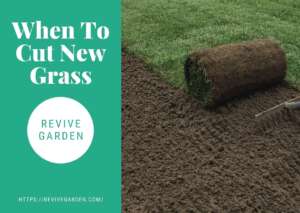Table of Contents
 Properly timing the cutting of new grass is essential for nurturing a lush and vibrant lawn. Achieving a healthy and well-maintained lawn requires understanding the growth cycle of new grass and implementing the right cutting schedule. Homeowners can promote strong root development and overall lawn health by following guidelines based on the growth stage, grass height, and mowing frequency.
Properly timing the cutting of new grass is essential for nurturing a lush and vibrant lawn. Achieving a healthy and well-maintained lawn requires understanding the growth cycle of new grass and implementing the right cutting schedule. Homeowners can promote strong root development and overall lawn health by following guidelines based on the growth stage, grass height, and mowing frequency.
New grass goes through distinct stages of growth, including germination, establishment, and maturity. During the initial stages, allowing the grass to establish robust root systems is crucial before regular mowing begins. Determining the ideal height for new grass is also important, as it affects the health and appearance of the lawn. Factors such as grass type, climate, and personal preferences play a role in determining the optimal height.
When to Start Cutting New Grass? – Timing Guidelines

Knowing when to start cutting new grass is essential for ensuring its proper growth and development. The timing for cutting new grass depends on the growth stage and the height of the grass. Here are some timing guidelines to help you determine when to start cutting new grass:
- Germination Stage: During germination, allowing the grass seedlings to establish strong root systems before cutting is important. Avoid mowing the grass until it has reached a height of about 3-4 inches. This usually takes a few weeks after seeding or sodding. Cutting too early can damage the fragile roots and hinder the growth of the grass.
- Establishment Stage: Once the grass has reached the recommended height for the germination stage, it enters the establishment stage. At this point, consider cutting the grass. The timing for cutting during this stage depends on the grass’s height. Aim to mow when the grass is about 50-70% taller than the desired height for your lawn. This allows the grass to establish a solid root system while maintaining an acceptable height.
- Maturity Stage: After the grass has successfully established itself, it enters maturity. This is when you can establish a regular mowing schedule. The timing for cutting during the maturity stage depends on the growth rate of your grass type. Cool-season grasses, such as Kentucky bluegrass or fescue, generally require more frequent mowing and can be cut every 5-7 days during active growth periods. Warm-season grasses, like Bermuda grass or St. Augustine grass, have a slower growth rate and may require mowing every 7-10 days.
Reasons to Cut the New Grass
Cutting the new grass is an essential aspect of lawn care that offers several benefits for your lawn’s overall health and appearance. Here are some reasons why cutting new grass is important:
- Encourages Stronger Root Development: Cutting the new grass promotes the growth of a stronger and deeper root system. When the grass is mowed, it triggers the plant’s natural response to growing new shoots and roots. This encourages the grass to develop a denser and more extensive root network, which improves its ability to absorb water and nutrients from the soil.
- Enhances Appearance and Aesthetic Appeal: Regularly cutting the new grass helps maintain an even and uniform lawn height, contributing to its visual appeal. Consistent mowing creates a neat and manicured look, enhancing the overall appearance of your lawn and making it more inviting and visually pleasing.
- Controls Weed Growth: Cutting the new grass at the appropriate height helps control the growth of weeds. By keeping the grass at a recommended height, you create shade and limit the sunlight available to weed seeds, preventing them from germinating and taking hold in your lawn. Additionally, mowing can help remove weed growth, reducing its spread and dominance.
- Prevents Excessive Thatch Buildup: Thatch refers to the layer of dead grass, roots, and organic debris that accumulates between the soil and the green vegetation of the grass. Regular mowing prevents excessive thatch buildup by cutting off the excess organic matter and preventing it from accumulating excessively. This helps maintain a healthier and more breathable lawn, reducing the risk of disease and pest issues.
- Stimulates Lateral Growth: Cutting the new grass stimulates lateral growth, causing the grass to spread and fill bare patches. Trimming the top growth encourages the grass to send out side shoots and tillers, leading to denser coverage and a more robust turf.
- Promotes Overall Lawn Health: Proper and timely mowing of new grass contributes to its overall health. It allows for better air circulation, reduces moisture retention, and helps prevent fungal diseases by avoiding overly long or damp grass blades. Additionally, regular mowing can help improve the grass’s tolerance to environmental stresses such as heat, drought, and foot traffic.
Precautions For Cutting New Grass

When cutting new grass, it’s important to take certain precautions to ensure the health and well-being of your lawn. Here are some precautions to keep in mind:
- Avoid Cutting Too Low: Cutting the grass too short, also known as scalping, can damage the grass and inhibit its growth. It weakens the grass, making it more susceptible to diseases, pests, and weed invasion. Follow the recommended mowing height for your grass type and avoid removing more than one-third of the grass blade length in a single mowing session.
- Use Sharp Mower Blades: Dull mower blades can tear and shred the grass instead of making clean cuts. This can result in an uneven and ragged appearance, stress, and damage to the grass. Regularly inspect and sharpen your mower blades to ensure a clean and precise cut. Dull blades can also contribute to disease susceptibility and slower grass recovery.
- Mow When the Grass is Dry: Mowing wet grass can lead to clumping and uneven cutting. Wet grass sticks to the mower blades, clogging the deck and impeding proper airflow. This can result in an uneven cut and create a breeding ground for fungal diseases. Aim to mow when the grass is dry for a cleaner and more efficient cut.
- Avoid Mowing in Extreme Heat: Mowing during the hottest part of the day, especially in extreme heat, can stress the grass and increase the risk of damage. The combination of heat stress from the sun and the stress caused by cutting can lead to brown patches and weaken the grass. When temperatures are more favorable, opt for mowing during cooler mornings or late afternoons.
- Alternate Mowing Patterns: Mowing in the same pattern every time can lead to compacted soil and create ruts in the lawn. Alternate your mowing pattern each time to avoid compaction and encourage upright grass growth. This helps prevent soil compaction and ensures an even distribution of foot traffic and mower weight across the lawn.
- Remove Debris and Obstacles: Before mowing, remove any debris, rocks, branches, or other objects from the lawn. These can damage your mower blades or cause accidents if struck. Clear the area of any potential obstacles to ensure a safe and efficient mowing process.
The Chart to Mow the Grass
| Grass Names | Mowing Height (inches) | Mow Time(inches) |
| Kentucky Bluegrass | 2 to 2.5 | 3 to 4 |
| Tall Fescue | 2 to 3 | 3 to 5 |
| Bermuda grass | 1 to 1.5 | 1.5 to 2 |
| Fine Fescue | 2 to 2.5 | 3 to 4 |
| Zoysia | 1 to 1.5 | 1.5 to 2 |
| Centipede | 1.5 to 2 | 2 to 3 |
| St. Augustine | 2.5 to 3 | 4 to 4.5 |
| Perennial Ryegrass | 1.5 to 2.5 | 2 to 4 |
Ways to Cut the Grass
Depending on your goal, there are several ways to cut the new grass.
- First, you should figure out what type of grass you have on your lawn.
- Most people just cut the new grass with a lawn mower. But if you want to be able to make your lawn look its best, it’s worth investing in one of these tools.
- For starters, grass needs to be cut at an angle—not straight on. If you don’t do this, the blades on your mower will chop up the stalks and not leave them looking green and healthy.
- You’ll also want to use a knuckle duster or hand clippers when cutting your lawn. These tools make it easier for you to get into awkward corners where regular clippers also wouldn’t work.
- If you have a push mower, you don’t need any special equipment—use it!
Final words
In conclusion, knowing when to cut the new grass is important. The reasons for this are to ensure that the grass is the right length, to prevent it from getting too long, and to avoid damaging the blades.
